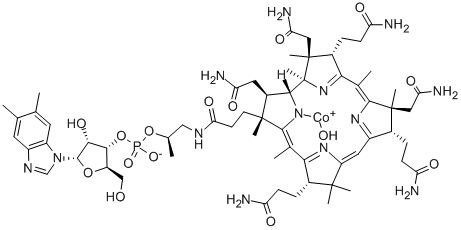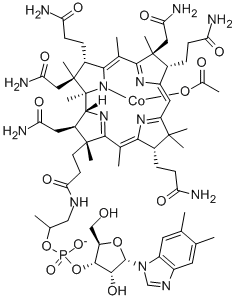Methylcobalamin , 10mMinDMSO , 13422-55-4
Synonym(s):
α-(5,6-Dimethylbenzimidazolyl)cyanocobamide;CN-Cbl;Cyanocob(III)alamin;Cyanocobalamin
CAS NO.:13422-55-4
Empirical Formula: C63H90CoN13O14P
Molecular Weight: 1343.4
MDL number: MFCD00082483
EINECS: 236-535-3
| Pack Size | Price | Stock | Quantity |
| 1ml | RMB159.20 | In Stock |
|
| others | Enquire |
PRODUCT Properties
| Melting point: | >190°C (dec.) |
| storage temp. | Sealed in dry,Store in freezer, under -20°C |
| solubility | DMSO (Slightly), Methanol (Sparingly), Water (Slightly) |
| pka | pK1:7.64(+1) (25°C) |
| form | Solid |
| color | Dark Red |
| Odor | Odorless |
| biological source | synthetic (organic) |
| Water Solubility | Partially soluble in cold water, hot water. |
| Stability: | Light Sensitie |
| InChIKey | JEWJRMKHSMTXPP-WYVZQNDMSA-L |
| LogP | -2.812 (est) |
| CAS DataBase Reference | 13422-55-4 |
Description and Uses
Methylcobalamin is an analog of vitamin B12 with diverse neurological activities. It promotes neurite outgrowth and survival in primary cerebellar granule (CGN) and dorsal root ganglion (DRG) cells and activation of ERK1/2 and Akt when used at concentrations ranging from 0.1 to 100 μM. Methylcobalamin (1 mg/kg per day) improves sensory function in a pinch test and increases toe spreading in a rat model of sciatic nerve injury. It decreases the number of atypical mitochondria in the sciatic nerve and reduces mechanical allodynia and thermal hyperalgesia induced by vincristine in a rat model of neuropathic pain. Methylcobalamin (30 mg/kg) reduces muscle weakness and forelimb contracture and increases bicep muscle weight and the number of musculocutaneous nerves in the wobbler mouse model of amyotrophic lateral sclerosis (ALS). It also enhances the recovery of compound muscle action potentials and motor end plate innervation and decreases the time to sticker removal in the sticker removal grooming test in a rat model of bicep ulnar to musculocutaneous nerve transfer.
Histamine receptor, Alzheimer research
Safety
| Symbol(GHS) |  GHS07 |
| Signal word | Warning |
| Hazard statements | H315-H319-H335 |
| Precautionary statements | P261-P264-P271-P280-P302+P352-P304+P340-P305+P351+P338-P312-P321-P362+P364-P332+P313-P337+P313-P403+P233-P405-P501 |
| Hazard Codes | Xi |
| Risk Statements | 36/37/38 |
| Safety Statements | 24/25-36-26 |
| WGK Germany | 2 |
| RTECS | GG3745000 |
| HS Code | 29362600 |
| Toxicity | LD50 oral in rat: > 5gm/kg |




